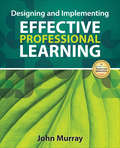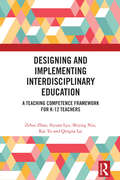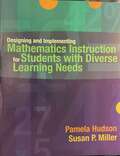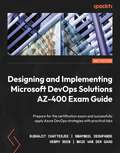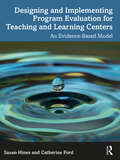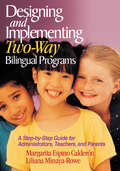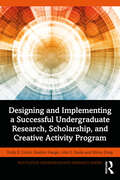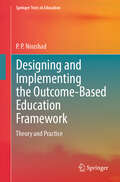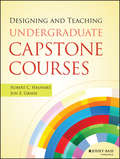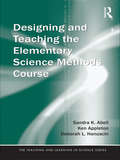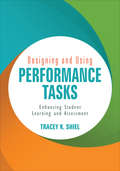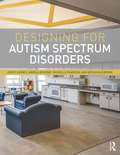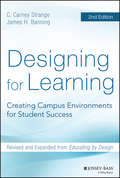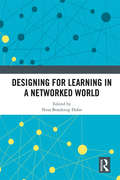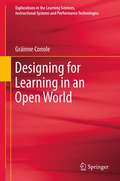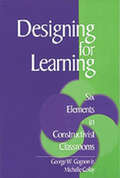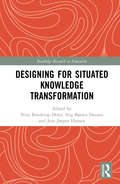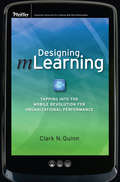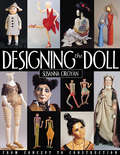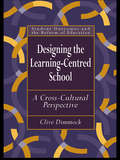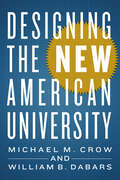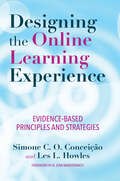- Table View
- List View
Designing and Implementing Effective Professional Learning
by John M. MurrayFor sustained success, educators must commit to their own lifelong improvement. A clear correlation exists between level of focus on teacher professional development (PD) and student success. In this book, John Murray identifies the characteristics of effective professional learning, detailing eight strategies for planning, and executing, and evaluating PD programs. Content includes: The proven “backward” approach to articulating the goals of your PD program Descriptions of innovative and effective designs for professional learning such as Lesson Study and Instructional Rounds Powerful approaches to designing and implementing online PD
Designing and Implementing Interdisciplinary Education: A Teaching Competence Framework for K-12 Teachers
by Zehui Zhan Siyuan Lyu Shijing Niu Kai Tu Qingna LaiInterdisciplinary education is the future trend in global K-12 curriculum reform, and all K-12 subject teachers should be prepared to meet the challenges it presents. This book aims to explore the competence structure that K-12 teachers need to effectively design and implement interdisciplinary education from a general perspective of subject integration.Drawing on relevant theories from interdisciplinary education and teacher competence research, the book clarifies the fundamental connotations of teachers’ interdisciplinary teaching competence and identifies the key elements of this competence from an international perspective. It also examines the transformation pathways for teachers from subject-specific teaching to interdisciplinary teaching based on China’s national curriculum framework. On this basis, the book constructs a framework for K-12 teachers’ interdisciplinary teaching competence and applies it to the cultivation of interdisciplinary teaching staff, guiding the design of assessment tools, improvement strategies, and training programs for enhancing interdisciplinary teaching competence.The book will encourage teachers from different disciplines to participate in the design and implementation of interdisciplinary teaching, thereby promoting the sustainable development of interdisciplinary education. Global educators and researchers interested in interdisciplinary education, competence framework development, teacher professional development, and Chinese education will find valuable insights in this book.
Designing and Implementing Mathematics Instruction for Students with Diverse Learning Needs
by Susan Miller Pamela HudsonThis exciting new book integrates the explicit teaching practices that have proven effective for students with disabilities with the NCTM math standards that dominant current mathematics practices in the United States . <p><p>In Part 1 of the book, teachers learn the fundamentals of mathematics assessment and instructional design for conceptual, declarative knowledge, procedural, and problem-solving lessons. In Part 2, the detailed scope and sequence charts, along with instructional guidelines keyed to the objectives, provide teachers with specific guidelines for assessment and design. <p><p>The curriculum-based assessment chapter (Ch. 2) helps teachers group students for instruction, place in curriculum, monitor performance, and make data based decisions. Content coverage of all five NCTM content standards provides teachers the support needed to access the general education curriculum and help their students meet annual yearly progress expectations (Chapters 7 ― 15). Detailed scope and sequence charts provide a valuable resource for assessing, planning, and designing instruction (Chapters 7-15). Instructional design discussion includes four domains: concepts, declarative knowledge, problem solving, and procedural knowledge. When teachers understand the function of the instruction, their effectiveness and efficiency are enhanced (Chapters 3-15). Integration of explicit teaching practices with NCTM approach helps teachers maintain practices that work for students with diverse needs while integrating reformed-based mathematics practices (in Chapters 1, 7-15). Detailed guidelines, including scripted lessons, on HOW to design and deliver effective instruction. These sample lessons illustrate how to apply the explicit teaching sequence to various content areas and provide examples for preservice and inservice teachers to use when developing their own lessons.
Designing and Implementing Microsoft DevOps Solutions AZ-400 Exam Guide: Prepare for the certification exam and successfully apply Azure DevOps strategies with practical labs, 2nd Edition
by Henry Been Maik van Gaag Subhajit Chatterjee Swapneel DeshpandeWritten by Microsoft MVPs and Azure experts, this comprehensive guide comes with self-study exercises to help you understand the concepts better and move closer to becoming a skilled Azure DevOps engineerKey FeaturesExplore a step-by-step approach to designing and creating a successful DevOps environmentUnderstand how to implement continuous integration and continuous deployment pipelines on AzureIntegrate and implement security, compliance, containers, and databases in your DevOps strategiesBook DescriptionThe AZ-400 Designing and Implementing Microsoft DevOps Solutions certification helps DevOps engineers and administrators get to grips with practices such as continuous integration and continuous delivery (CI/CD), containerization, and zero downtime deployments using Azure DevOps Services.This new edition is updated with advanced topics such as site reliability engineering (SRE), continuous improvement, and planning your cloud transformation journey. The book begins with the basics of CI/CD and automated deployments, and then moves ahead to show you how to apply configuration management and Infrastructure as Code (IaC) along with managing databases in DevOps scenarios. As you make progress, you'll explore fitting security and compliance with DevOps and find out how to instrument applications and gather metrics to understand application usage and user behavior. This book will also help you implement a container build strategy and manage Azure Kubernetes Services. Lastly, you'll discover quick tips and tricks to confidently apply effective DevOps practices and learn to create your own Azure DevOps organization.By the end of this DevOps book, you'll have gained the knowledge needed to ensure seamless application deployments and business continuity.What you will learnGet acquainted with Azure DevOps Services and DevOps practicesDiscover how to efficiently implement CI/CD processesBuild and deploy a CI/CD pipeline with automated testing on AzureIntegrate security and compliance in pipelinesUnderstand and implement Azure Container ServicesEffectively close the loop from production back to developmentApply continuous improvement strategies to deliver innovation at scaleWho this book is forThe book is for anyone looking to prepare for the AZ-400 certification exam. Software developers, application developers, and IT professionals who want to implement DevOps practices for the Azure cloud will also find this book helpful. Familiarity with Azure DevOps basics, software development, and development practices is recommended but not necessary.
Designing and Implementing Program Evaluation for Teaching and Learning Centers: An Evidence-Based Model
by Catherine Ford Susan HinesThis practical guide equips educational developers with a clear, systematic approach to evaluating the impact of their center’s programs.Evaluation data and evidence can serve as powerful tools to demonstrate alignment with strategic priorities and to construct compelling narratives that highlight the value added by educational development opportunities. Drawing from 10 years of in-depth research investigating how teaching and learning centers evaluate their programs, this book provides a four-phase model flexible enough to fit centers of any size. The authors’ accessible, outcomes-based approach outlines essential steps and strategies in designing and implementing an evaluation plan tailored to their center’s specific needs. The illustrative figures, practical examples, customizable templates, and real-world scenarios ensure that the model is comprehensive, while also being straightforward and easy to apply.This book is an indispensable resource for directors and staff working in teaching and learning centers, chief academic officers and deans, and administrators responsible for educational development at the college level.
Designing and Implementing Two-Way Bilingual Programs: A Step-by-Step Guide for Administrators, Teachers, and Parents
by Margarita Espino Calderon Dr Liliana Minaya-RoweThis indispensable handbook includes professional development plans that meet the specific needs of dual-language programs, strategies for building learning communities for dual-language teachers, and tips for involving parents.
Designing and Implementing a Successful Undergraduate Research, Scholarship and Creative Activity Program (Routledge Undergraduate Research Series)
by John Banks Holly Unruh Heather Haeger Winny DongDesigning and Implementing a Successful Undergraduate Research, Scholarship and Creative Activity Program is designed as a resource for faculty, administrators, and university leaders interested in developing new, or expanding existing, undergraduate research programs. The book provides a practical handbook addressing the many "how to" questions associated with running a successful undergraduate research enterprise – ranging from how to organize an undergraduate research office, to how to find funding, foster cross-campus relationships, and develop learning outcomes for students in order to maximize the benefits of the research experience. It also addresses best practices in mentoring, how faculty mentorship fits within the discussion of tenure and promotion, and the basics of assessment, for both funder reporting and program improvement.Containing a series of vignettes offering specific advice from program directors, faculty mentors, and university administrators from a diverse array of universities and colleges, this book showcases their hands-on tips, advice, and lessons learned. Addressing key issues through real-world experience, the authors show how to build effective cross-disciplinary undergraduate research programs with positive impacts for students and faculty.
Designing and Implementing the Outcome-Based Education Framework: Theory and Practice (Springer Texts in Education)
by P. P. NoushadThis textbook presents a theoretical overview of the idea of Outcome Based Education (OBE), together with research and practical inputs for practitioners. It discusses the evolution of the ideas of OBE, Aligning Outcome and Curricular Content, Aligning Outcome and Modes of Transaction, and Aligning Outcome and Evaluation. It also provides practical guidelines with illustrations on how to design courses and curricula for school education, as well as higher education, using the OBE Framework. It serves as a useful guide for students, teachers of all levels, teacher educators, and other educational practitioners.
Designing and Teaching Undergraduate Capstone Courses
by Jon E. Grahe Robert C. HauhartEnrich your students and the institution with a high-impact practiceDesigning and Teaching Undergraduate Capstone Courses is a practical, research-backed guide to creating a course that is valuable for both the student and the school. The book covers the design, administration, and teaching of capstone courses throughout the undergraduate curriculum, guiding departments seeking to add a capstone course, and allowing those who have one to compare it to others in the discipline. The ideas presented in the book are supported by regional and national surveys that help the reader understand what's common, what's exceptional, what works, and what doesn't within capstone courses. The authors also provide additional information specific to different departments across the curriculum, including STEM, social sciences, humanities, fine arts, education, and professional programs.Identified as a high-impact practice by the National Survey of Student Engagement (NSSE) and the Association of American Colleges and Universities' LEAP initiative, capstone courses culminate a student's final college years in a project that integrates and applies what they've learned. The project takes the form of a research paper, a performance, a portfolio, or an exhibit, and is intended to showcase the student's very best work as a graduating senior. This book is a guide to creating for your school or department a capstone course that ties together undergraduate learning in a way that enriches the student and adds value to the college experience.Understand what makes capstone courses valuable for graduating studentsDiscover the factors that make a capstone course effective, and compare existing programs, both within academic disciplines and across institutionsLearn administrative and pedagogical techniques that increase the course's successExamine discipline-specific considerations for design, administration, and instructionCapstones are generally offered in departmental programs, but are becoming increasingly common in general education as well. Faculty and administrators looking to add a capstone course or revive an existing one need to understand what constitutes an effective program. Designing and Teaching Undergraduate Capstone Courses provides an easily digested summary of existing research, and offers expert guidance on making your capstone course successful.
Designing and Teaching the Elementary Science Methods Course (Teaching and Learning in Science Series)
by Ken Appleton Sandra K. Abell Deborah L. HanuscinWhat do aspiring and practicing elementary science teacher education faculty need to know as they plan and carry out instruction for future elementary science teachers? This scholarly and practical guide for science teacher educators outlines the theory, principles, and strategies needed, and provides classroom examples anchored to those principles. The theoretical and empirical foundations are supported by scholarship in the field, and the practical examples are derived from activities, lessons, and units field-tested in the authors’ elementary science methods courses. Designing and Teaching the Elementary Science Methods Course is grounded in the theoretical framework of pedagogical content knowledge (PCK), which describes how teachers transform subject matter knowledge into viable instruction in their discipline. Chapters on science methods students as learners, the science methods course curriculum, instructional strategies, methods course assessment, and the field experience help readers develop their PCK for teaching prospective elementary science teachers. "Activities that Work" and "Tools for Teaching the Methods Course" provide useful examples for putting this knowledge into action in the elementary science methods course.
Designing and Using Performance Tasks: Enhancing Student Learning and Assessment
by Tracey K. ShielStretch student thinking with performance-based tasks. With the continual increase of high-stakes assessments also comes the surge of professional development on designing performance-based tasks. Providing step-by-step insights, this book shows you how to incorporate performance tasks as a tool to teach, monitor, and extend student learning. If you’re ready to stretch your students’ thinking, grab a copy of this how-to guide to help you: Make instructional decisions based on student performance of learning tasks Incorporate learning progressions as an integral part of planning performance tasks Close the “knowing–doing” gap by focusing on considerations for successful implementation
Designing and Using Performance Tasks: Enhancing Student Learning and Assessment
by Tracey K. ShielStretch student thinking with performance-based tasks. With the continual increase of high-stakes assessments also comes the surge of professional development on designing performance-based tasks. Providing step-by-step insights, this book shows you how to incorporate performance tasks as a tool to teach, monitor, and extend student learning. If you’re ready to stretch your students’ thinking, grab a copy of this how-to guide to help you: Make instructional decisions based on student performance of learning tasks Incorporate learning progressions as an integral part of planning performance tasks Close the “knowing–doing” gap by focusing on considerations for successful implementation
Designing for Autism Spectrum Disorders
by Angela Bourne Michelle Pearson Kristi Gaines Mesha KleibrinkWinner of the 2017 IDEC Book Award, 2017 EDRA Great Places Award (Book Category), 2017 American Society of Interior Designers Joel Polsky Prize and the 2016 International Interior Design Association TXOK Research Award Designing for Autism Spectrum Disorders explains the influence of the natural and man-made environment on individuals with autism spectrum disorders (ASD) and other forms of intellectual/developmental disabilities (IDD). Drawing on the latest research in the fields of environmental psychology and education, the authors show you how architecture and interior spaces can positively influence individuals with neurodiversities by modifying factors such as color, lighting, space organization, textures, acoustics, and ventilation. Now you can design homes, therapeutic environments, work environments, and outdoor spaces to encourage growth and learning for the projected 500,000 children with ASD (in the United States alone) who are expected to reach adulthood by 2024. Topics discussed include:-Environmental design theories-Symptoms of ASD-Sensory processing deficits -Design needs of individuals on the spectrum at all ages-Design methods and solutions for spaces, including residential, learning, work, and therapeutic environments encompassing a wide range of budgets-Designing for self-actualization, well-being, and a high quality of life for the duration of an individual's life-Avenues for healthy living and aging in place-Biophilic design-Environmental impact on well-being -Strategies to promote active living as an integral part of the welfare focus.
Designing for Depth in the Classroom: A Framework for Purposeful Differentiation
by Andi McNairDifferentiate your gifted classroom by designing experiences instead of writing lessons plans with Designing for Depth in the Classroom: A Framework for Purposeful Differentiation. Addressing the specific needs of countless learners doesn’t have to be overwhelming and unsustainable! In her dynamic new book, Andi McNair guides readers through a fresh mindset and process for designing meaningful experiences that leave learners engaged, empowered, and motivated to move from surface-level learning to deep understanding. Chapters cover topics such as project-based learning, authentic engagement, supporting and encouraging learners in the classroom and beyond, and the many ways to provide depth, with space provided at the end of each chapter for reflection questions and key takeaways. With practical strategies, advice, and examples imparted in a refreshing conversational tone, this valuable resource is required reading for all educators interested in challenging and exciting their students in a meaningful and manageable way.
Designing for Learning
by C. Carney Strange James H. BanningUnderstand the design factors of campus environmental theory that impact student success and create a campus of consequence Designing for Learning is a comprehensive introduction to campus environmental theory and practice, summarizing the influence of collegiate environments on learning and providing practical strategies for facilitating student success through intentional design. This second edition offers new coverage of universal design, learning communities, multicultural environments, online environments, social networking, and safety, and challenges educators to evaluate the potential for change on their own campuses. You'll learn which factors make a living-learning community effective, and how to implement these factors in the renovation of campus facilities. An updated selection of vignettes, case scenarios, and institutional examples help you apply theory to practice, and end-of-chapter reflection questions allow you to test your understanding and probe deeper into the material and how it applies to your environment. Campus design is no longer just about grassy quads and ivy-covered walls--the past decade has seen a surge in new designs that facilitate learning and nurture student development. This book introduces you to the many design factors that impact student success, and helps you develop a solid strategy for implementing the changes that can make the biggest difference to your campus. Learn how environments shape and influence student behavior Evaluate your campus and consider the potential for change Make your spaces more welcoming, inclusive, and functional Organize the design process from research to policy implementation Colleges and universities are institutions of purpose and place, and the physical design of the facilities must be undertaken with attention to the ways in which the space's dimensions and features impact the behavior and outlook of everyone from students to faculty to staff. Designing for Learning gives you a greater understanding of modern campus design, and the practical application that brings theory to life.
Designing for Learning in a Networked World (Routledge Research in Education)
by Nina Bonderup DohnDesigning for Learning in a Networked World provides answers to the following questions: what skills are required for living in a networked world; how can educators design for learning these skills and what role can and should networked learning play in a networked world? It discusses central theoretical concepts and draws on current debates about competences necessary to thrive in contemporary society. The book presents detailed analyses of skills needed and investigates the question of how one can design for learning in specific empirical cases, ranging in academic level from preschool to university teaching. The book clarifies the different conceptions of design within the educational field and offers a framework for thinking critically about instances of networked learning. It analyses digital and Computational Literacy and discusses participatory skills for learning in a networked world. Examples of specific empirical cases include teaching programming to students not necessarily intrinsically motivated to learn; facilitation of a participatory public in the library and designs for children’s transition from day-care to primary school, discussed as a matter of networked contexts. Engaging thoughtfully with the question of ‘21st century skills’, this book will be vital reading to scholars, researchers and students within the fields of education, networked learning, learning technology and the learning sciences, digital literacy, design for learning, and library studies.
Designing for Learning in an Open World
by Gráinne ConoleThe Internet and associated technologies have been around for almost twenty years. Networked access and computer ownership are now the norm. There is a plethora of technologies that can be used to support learning, offering different ways in which learners can communicate with each other and their tutors, and providing them with access to interactive, multimedia content. However, these generic skills don't necessarily translate seamlessly to an academic learning context. Appropriation of these technologies for academic purposes requires specific skills, which means that the way in which we design and support learning opportunities needs to provide appropriate support to harness the potential of technologies. More than ever before learners need supportive 'learning pathways' to enable them to blend formal educational offerings, with free resources and services. This requires a rethinking of the design process, to enable teachers to take account of a blended learning context.
Designing for Learning: Six Elements in Constructivist Classrooms
by Michelle Collay George W. GagnonIntroducing CLD – Constructivist Learning Design – a new and different way of thinking about learning and teaching. Teaching and learning are two sides of the same coin; this ground-breaking book realizes that, and builds on the pioneering work of Piaget and Vygotsky to offer a new approach to the constructivist classroom. Learn how to organize groups, build bridges, ask questions, arrange exhibits, and invite reflection in the creation of whole new – and successful – teaching/learning designs. A major new work for students of teaching, teachers, administrators, and parents who want to know how to apply constructivist learning theory in the classroom.
Designing for Learning: Six Elements in Constructivist Classrooms
by Michelle Collay George W. GagnonIntroducing CLD – Constructivist Learning Design – a new and different way of thinking about learning and teaching. Teaching and learning are two sides of the same coin; this ground-breaking book realizes that, and builds on the pioneering work of Piaget and Vygotsky to offer a new approach to the constructivist classroom. Learn how to organize groups, build bridges, ask questions, arrange exhibits, and invite reflection in the creation of whole new – and successful – teaching/learning designs. A major new work for students of teaching, teachers, administrators, and parents who want to know how to apply constructivist learning theory in the classroom.
Designing for Situated Knowledge Transformation (Routledge Research in Education)
by Nina Bonderup Dohn Stig Børsen Hansen Jens Jørgen HansenHow can knowledge developed in one context be put to use in other contexts? How can students learn to do so? How can educators design for learning this? These are fundamental challenges to many forms of education. The challenges are amplified in contemporary society where people traverse many different contexts and where contexts themselves are continuously changing. Designing for Situated Knowledge Transformation provides a structured answer to these questions, through an investigation of the theoretical, empirical, methodological and pedagogical design aspects which they involve. Raising profound questions about the nature of knowledge, of situativity, and of transfer, transformation and resituation, it calls for and provides extended empirical studies of the forms of transformation that knowledge undergoes when people find themselves in new contexts while relying on existing knowledge. Considering many avenues of practical application and insight, Designing for Situated Knowledge Transformation develops a coherent framework for developing learning designs for knowledge transformation that is crucial in today’s educational settings.
Designing mLearning
by Clark N. QuinnMobile is a powerful new tool for supporting organizational performance, including a wide-variety of learning opportunities including innovation, collaboration, research, and design. Mobile generates new products, services, and helps solve problems. Whether providing needed tools, augmenting learning, or connecting individuals, mobile devices are empowering individuals and organizations.Designing mLearning is a hands-on resource that presents step-by-step guidance for designing, delivering, and deploying mobile solutions, covering both the background model and pragmatic considerations for successfully navigating mobile projects. The book takes an integrated approach to mobile learning regardless of the device used. Written by Dr. Clark Quinn, a noted leader in the mLearning revolution, Designing mLearning debunks commonly held myths about mLearning, defines the myriad opportunities for mobile, contains real-world, illustrative examples, includes implementation concerns, and places mobile learning in an overall strategic plan.Designing mLearning is written for instructional designers, developers, media experts, managers, and anyone with responsibility for supporting performance in organizations. While the focus is on the design of solutions, the book addresses the critical organizational issues to assist the larger agenda of mobilizing the organization.The information outlined in this groundbreaking guide can be applied across the mobile device spectrum and provides a systematic and integrated suite of conceptual frameworks to guide designers to pragmatic and effective solutions."Quinn takes you by the hand and leads you carefully and comprehensively through the m-learning maze of devices, models, examples, and designs, at the same time demonstrating that mobile learning is more than being about learning, but is also about performance."--Jane Hart, founder & CEO, Centre for Learning and Performance Technologies"Stop thinking mLearning is miniaturized eLearning. Just as digital video has enabled entirely new forms of entertainment and communication, mLearning enables powerful new (and old) performance solutions at very low costs. Clark omits the deafening hyperbole and delivers today's best source of clear, complete, and useful mLearning guidance for us all."--Michael Allen, CEO, Allen Interactions"The future is mobile. It will rock you more than the web did. And Clark Quinn has written the missing manual."--Jay Cross, CEO, Internet Time, and author, Informal Learning"Those of us in learning and development know we spend a disproportionate amount of time on formal training, missing opportunities to support workers where real learning occurs: in work, every day. With a wealth of examples, Clark Quinn provides a clear, useful guidebook for using 21st-century tools to support our performers as they enact their work and apply new learning."--Jane Bozarth, Ed.D., author, Social Media for Trainers and Better Than Bullet Points"Yes, this is a handy book about mobile learning and support. But it's also a thoughtful nudge towards rethinking what we mean when we say we are educators."--Allison Rossett, San Diego State University"Clark Quinn sets the pace for a swift race toward mobile everything. His thought-leadership and focus on solutions that work make him the one to watch, to read, and to learn from now!"--Marcia Conner, advisor in business culture and collaboration, co-author of The New Social Learning: A Guide to Transforming Organization Through Social Media
Designing the Doll: From Concept to Construction
by Susanna OroyanThe author of Anatomy of a Doll “gives us a gift by distilling the spirits found in doll/figure art . . . then explains the fundamentals to pave the way” (Barbara Campbell, editor of Soft Dolls & Animals!).Advance your dollmaking skills with this in-depth guide by master-dollmaker Susanna Oroyan! Susanna introduces you to her concept of “imaginative engineering” with a collection of design directions and technical processes that will help your ideas translate into reality.Expands on concepts presented in Anatomy of a Doll and Fantastic Figures.Covers a wide variety of construction methods, such as applications of wire armature in body construction, general concepts of mold making, sculpture mechanics, in-depth discussion of jointed figures, and methods of assembling your doll.More than 250 full-color photos of dolls from 130 of the world’s top doll artists. Over 200 detailed illustrations.Explains elements of design, such as focal point, scale, harmony, style, and the use of color, texture, and pattern. Learn techniques of proportion for working with the human figure.An excellent technical resource and reference book that will teach you how to develop ideas, then construct advanced art figures or dolls.“The doll world has only just recovered from the excitement of having Anatomy of a Doll which showed us what was possible. Now we can learn to get it with this new effort, the fabulous Designing the Doll. Thank you, Susanna, where would we be without you?” —Elinor Peace Bailey, author of Storytelling with Dolls“Demystifies the creation of dolls by offering techniques, basic construction and some very good thoughts on design . . . Filled with diagrams and color photos of dolls from some of the top contemporary doll-makers, inspiration is on every page.” —Polymer Clay
Designing the Learning-centred School: A Cross-cultural Perspective (Student Outcomes And The Reform Of Education Ser.)
by Clive DimmockSchools are expected and challenged to achieve student outcomes commensurate with the abilities of all students, but few are capable of this. This book demonstrates that present school structures and processes need to be redesigned, and suggests ways of reforming schools to enhance student outcomes. The author suggests that a holistic approach that integrates all facets of school life - learning, teaching, curriculum, school structures, resources, leadership and management - is needed. A practical and coherent model is used, underpinned by research evidence of what works and how practitioners can apply best practice to improvements for student outcomes.
Designing the New American University
by Michael M. Crow William B. DabarsA radical blueprint for reinventing American higher education.America’s research universities consistently dominate global rankings but may be entrenched in a model that no longer accomplishes their purposes. With their multiple roles of discovery, teaching, and public service, these institutions represent the gold standard in American higher education, but their evolution since the nineteenth century has been only incremental. The need for a new and complementary model that offers broader accessibility to an academic platform underpinned by knowledge production is critical to our well-being and economic competitiveness.Michael M. Crow, president of Arizona State University and an outspoken advocate for reinventing the public research university, conceived the New American University model when he moved from Columbia University to Arizona State in 2002. Following a comprehensive reconceptualization spanning more than a decade, ASU has emerged as an international academic and research powerhouse that serves as the foundational prototype for the new model. Crow has led the transformation of ASU into an egalitarian institution committed to academic excellence, inclusiveness to a broad demographic, and maximum societal impact.In Designing the New American University, Crow and coauthor William B. Dabars—a historian whose research focus is the American research university—examine the emergence of this set of institutions and the imperative for the new model, the tenets of which may be adapted by colleges and universities, both public and private. Through institutional innovation, say Crow and Dabars, universities are apt to realize unique and differentiated identities, which maximize their potential to generate the ideas, products, and processes that impact quality of life, standard of living, and national economic competitiveness. Designing the New American University will ignite a national discussion about the future evolution of the American research university.
Designing the Online Learning Experience: Evidence-Based Principles and Strategies
by Simone C. Conceição Les HowlesThis book provides instructors with a holistic way of thinking about learners, learning, and online course design. The distinctive strategies derived from an integrated framework for designing the online learning experience help create an experience that is more personalized, engaging, and meaningful for online learners.The focus of this book is on the learners and the design of their online learning experiences. The authors refer to learning design instead of instructional design – which focuses on instruction and places the instructor at the center stage of the process. Therefore, the focus is on approaching a learner’s online course experience as a journey consisting of a combination of learning interactions with content, instructor, and other learners. In most online courses, instructors and learners are separated in time and space and depend on technology to facilitate interactions that often lack a strong personal dimension. As online learning continues to proliferate and mature, the emphasis on simply making content available to students online is no longer acceptable. Creating online courses now requires a new way of thinking that incorporates new design ideas and approaches from a variety of fields; it also requires a new set of learning design skills for instructors and course designers.Organized into eight chapters, this volume focuses on enhancing online learning experiences for each of the major aspects of an online course, providing evidence-based principles and strategies to promote learner engagement and deep learning. The concluding chapter provides an example illustrating a real-world application of the principles and strategies covered in the book, using Design Thinking to create learning experiences.This book provides strategies for approaching the learning experience from an integrative perspective for both experienced online instructors and those new to online course design. These strategies are based on evidence-based learning design principles and encourage the reader to adopt an empathic mindset focused on the experience of the learner.
